He Interior of the Sun Effectively Produces a Continuous Spectrum These Photons Escape to Space
The Sun--The Closest Star
Chapter index in this window — — Chapter index in separate window -- Please support this website
Video lecture for this page
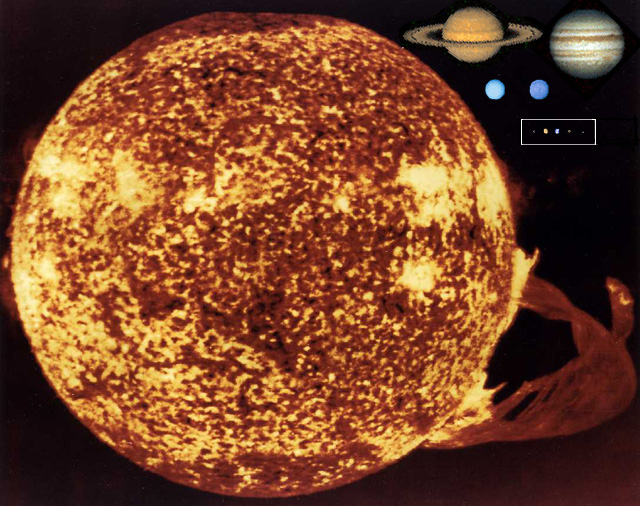
Size
The Sun is by far the biggest thing in the solar system. From its angular size of about 0.5° and its distance of almost 150 million kilometers, its diameter is determined to be 1,392,000 kilometers. This is equal to 109 Earth diameters and almost 10 times the size of the largest planet, Jupiter. All of the planets orbit the Sun because of its enormous gravity. It has about 333,000 times the Earth's mass and is over 1,000 times as massive as Jupiter. It has so much mass that it is able to produce its own light. This feature is what distinguishes stars from planets.Composition
What is the Sun made of? Spectroscopy shows that hydrogen makes up about 94% of the solar material, helium makes up about 6% of the Sun, and all the other elements make up just 0.13% (with oxygen, carbon, and nitrogen the three most abundant ``metals''---they make up 0.11%). In astronomy, any atom heavier than helium is called a ``metal'' atom. The Sun also has traces of neon, sodium, magnesium, aluminum, silicon, phosphorus, sulfur, potassium, and iron. The percentages quoted here are by the relative number of atoms. If you use the percentage by mass, you find that hydrogen makes up 78.5% of the Sun's mass, helium 19.7%, oxygen 0.86%, carbon 0.4%, iron 0.14%, and the other elements are 0.54%.The Sun's Interior
Here are the parts of the Sun starting from the center and moving outward.Core
The core is the innermost 10% of the Sun's mass. It is where the energy from nuclear fusion is generated. Because of the enormous amount of gravity compression from all of the layers above it, the core is very hot and dense. Nuclear fusion requires extremely high temperatures and densities. The Sun's core is about 16 million K and has a density around 160 times the density of water. This is over 20 times denser than the dense metal iron which has a density of ``only'' 7 times that of water. However, the Sun's interior is still gaseous all the way to the very center because of the extreme temperatures. There is no molten rock like that found in the interior of the Earth.Radiative Zone
The radiative zone is where the energy is transported from the superhot interior to the colder outer layers by photons. Technically, this also includes the core. The radiative zone includes the inner approximately 85% of the Sun's radius.Convective Zone
Energy in the outer 15% of the Sun's radius is transported by the bulk motions of gas in a process called convection. At cooler temperatures, more ions are able to block the outward flow of photon radiation more effectively, so nature kicks in convection to help the transport of energy from the very hot interior to the cold space. This part of the Sun just below the surface is called the convection zone.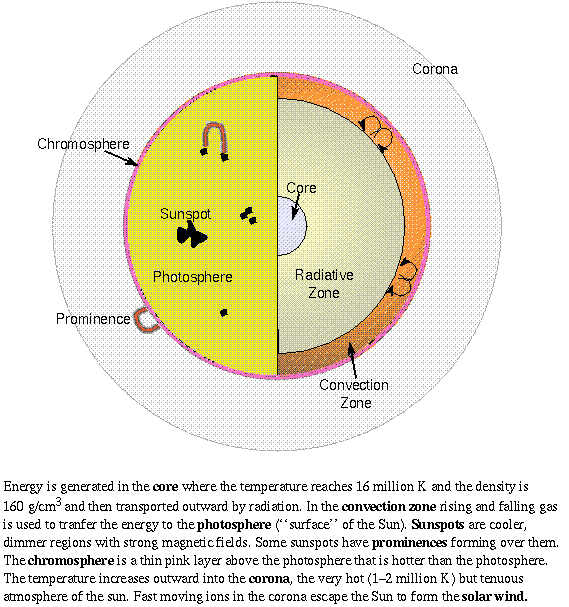
The Sun's Surface
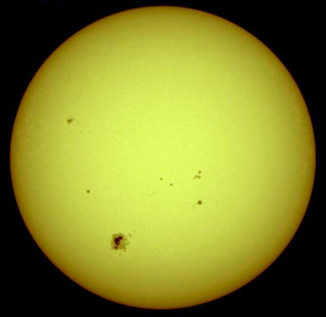 The deepest layer of the Sun you can see is the photosphere. The word ``photosphere'' means ``light sphere''. It is called the ``surface'' of the Sun because at the top of it, the photons are finally able to escape to space. The photosphere is about 500 kilometers thick. Remember that the Sun is totally gaseous, so the surface is not something you could land or float on. It is a dense enough gas that you cannot see through it. It emits a continuous spectrum. Several methods of measuring the temperature all determine that the Sun's photosphere has a temperature of about 5840 K.
The deepest layer of the Sun you can see is the photosphere. The word ``photosphere'' means ``light sphere''. It is called the ``surface'' of the Sun because at the top of it, the photons are finally able to escape to space. The photosphere is about 500 kilometers thick. Remember that the Sun is totally gaseous, so the surface is not something you could land or float on. It is a dense enough gas that you cannot see through it. It emits a continuous spectrum. Several methods of measuring the temperature all determine that the Sun's photosphere has a temperature of about 5840 K. Measuring the Sun's Temperature
One method, called Wien's law, uses the wavelength of the peak emission, Another method uses the flux of energy reaching the Earth and the inverse square law. Recall from the Stellar Properties chapter that the flux is the amount of energy passing through a unit area (e.g., 1 meter2) every second. From the inverse square law of light brightness, you find that the solar flux at the Earth's distance = the Sun's surface flux × (Sun's radius/Earth's distance)2 = 1380 Watts/meter2. Since the Sun's photosphere is approximately a thermal radiator, the flux of energy at its surface = ![]() × (the Sun's surface temperature)4, where
× (the Sun's surface temperature)4, where ![]() is the Stefan-Boltzmann constant. Rearranging the equation, the photosphere's temperature = [(solar flux at Earth)/
is the Stefan-Boltzmann constant. Rearranging the equation, the photosphere's temperature = [(solar flux at Earth)/![]() ) × (Earth distance/Sun's radius)2]1/4.
) × (Earth distance/Sun's radius)2]1/4.
These two methods give a rough temperature for the Sun of about 5800 K. The upper layers of the photosphere are cooler and less dense than the deeper layters, so you see absorption lines in the solar spectrum. Which element absorption lines are present and their strength depends sensitively on the temperature. You can use the absorption line strengths as an accurate temperature probe to measure a temperature of about 5840 K.
Features on the Photosphere
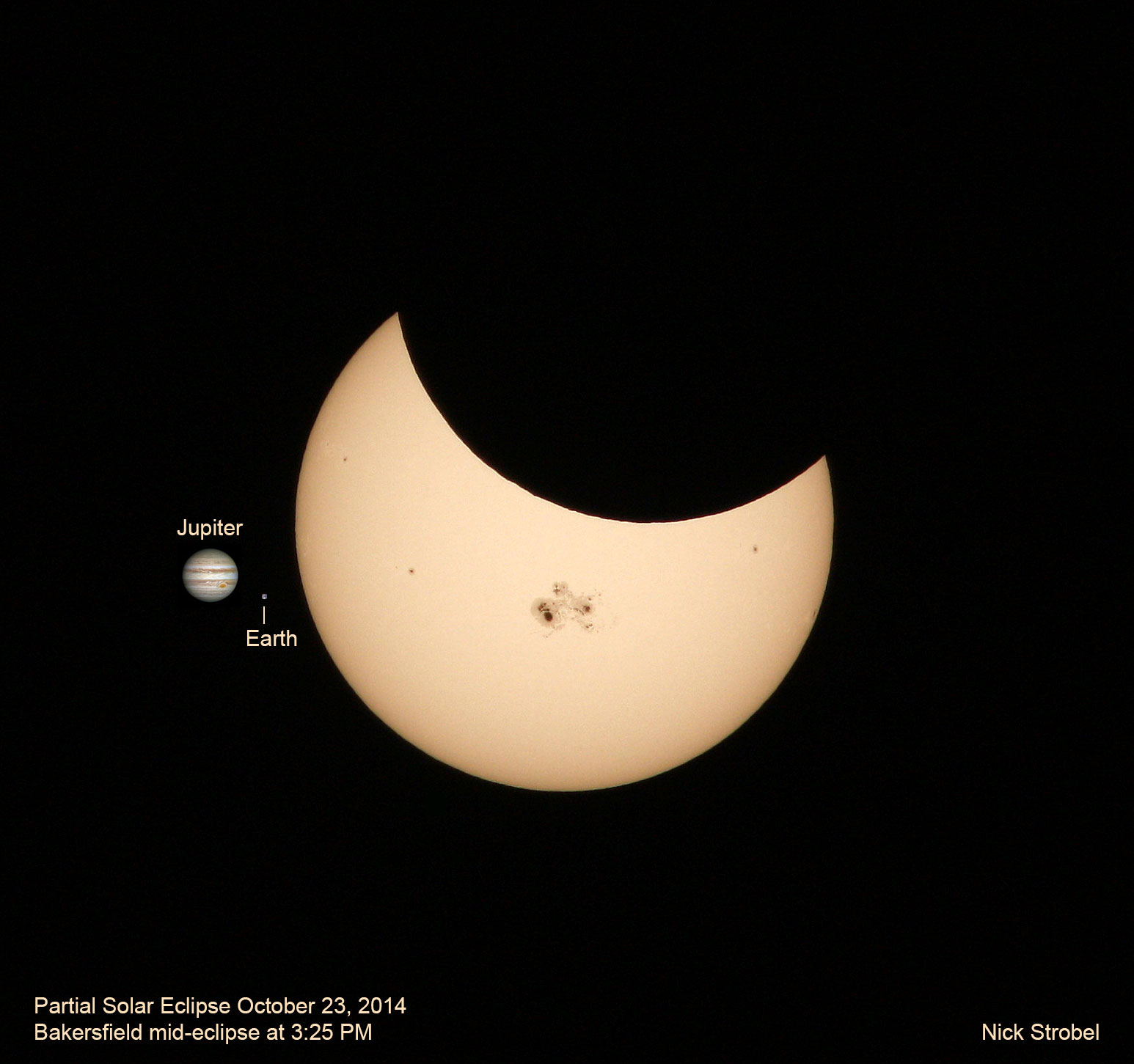
Sun at mid-eclipse 2014 showing size of sunspot group compared to Jupiter and Earth
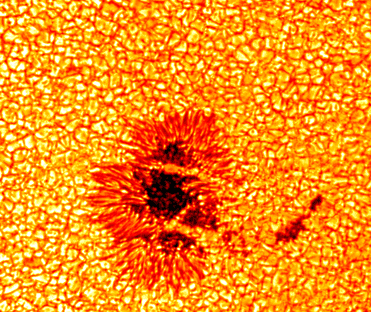 --
-- 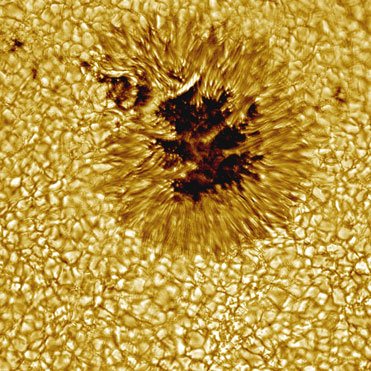
Sunspots + granulation in the photosphere (left: courtesy of Peter N. Brandt; right: courtesy of NSO)
Galileo discovered that the Sun's surface is sprinkled with small dark regions called sunspots. Sunspots are cooler regions on the photosphere. Since they are 1000--1500 K cooler than the rest of the photosphere, they do not emit as much light and appear darker. They can last a few days to a few months. Galileo used the longer-lasting sunspots to map the rotation patterns of the Sun. Because the Sun is gaseous, not all parts of it rotate at the same rate. The solar equator rotates once every 25 days, while regions at 30° above and below the equator take 26.5 days to rotate and regions at 60° from the equator take up to 30 days to rotate.
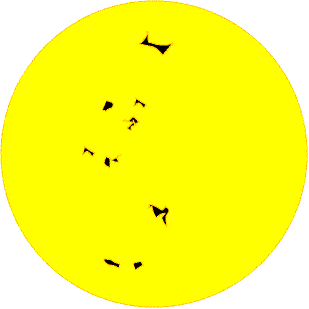
Animation begins with sunspots at different latitudes lined up. The sequence ends after one rotation of the equator---the sunspots near the poles have not appeared yet---and the animation starts over.
Hundreds of years of observing the sunspots on the Sun shows that the number of sunspots varies in a cycle with an average period of 11 years. At the start of a sunspot cycle the number of sunspots is at a minimum and most of them are at around 35° from the solar equator. At solar maximum when the sunspot number peaks about 5.5 years later, most of the sunspots are within just 5° of the solar equator.
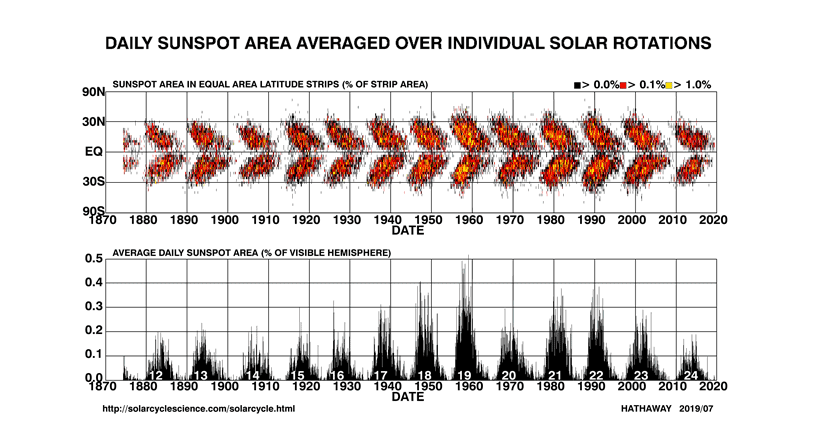
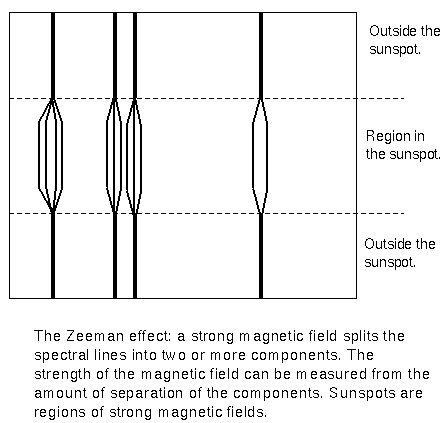
Sunspots are regions of strong magnetic fields. This affects the spectral lines in the sunspot spectra. Each absorption lines will split up into multiple components. The amount of separation between the components measures the strength of the magnetic field. The magnetic field is somehow responsible for the sunspot cycle. In one 11-year cycle the leading sunspot in a sunspot group will have a north magnetic pole while the trailing sunspot in the group will have a south magnetic pole. In the next 11-year cycle the poles will switch so the total cycle is 22 years long. Sunspots form where twisted magnetic field lines rise out of the photosphere and then loop back down into the photosphere and deeper layers. The magnetic field lines suppress the convection at those points on the photosphere so energy has a harder time leaking out at those points on the photosphere---they are cooler than the rest of the photosphere.
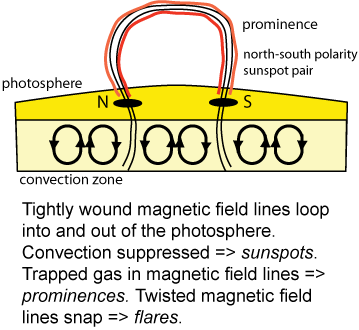
How many sunspots are there today on the Sun? See today's image of the photosphere at the SOHO website or the National Solar Observatory's GONG website or the Solar Dynamics Observatory website. The Sunspot Cycle page of the Solar Physics website at the Marshall Space Flight Center has a link to the sunspot numbers back to 1750 and David Hathaway has current data on the Solar Cycle Science website. The National Oceanic & Atmospheric Administration (NOAA) is now tasked with keeping watch on solar particle outflow and its interaction with our magnetic field (called "space weather") and it displays its tracking of the sunspot number on its Solar Cycle Progression page of the Space Weather Prediction Center.
At solar maximum there are more prominences and solar flares. Prominences are bright clouds of gas forming above the sunspots in the chromosphere that follow the magnetic field line loops. So-called ``quiet'' ones form in the corona (the Sun's atmosphere) about 40,000 kilometers above the surface. Sometimes they form loops of hydrogen gas as the gas follows the loops in the magnetic field. Quiet prominences last several days to several weeks. ``Surge'' prominences lasting up to a few hours shoot gas up to 300,000 kilometers above the photosphere.

The smallest of the loop prominences shown here is over three times bigger than the Earth (courtesy of National Solar Observatory/Sacramento Peak Observatory).
Solar flares are eruptions more powerful than surge prominences (a flare is shown in the Sun + planets montage above). They will last only a few minutes to a few hours. They probably form when the magnetic field lines get so twisted, that they snap violently, releasing the trapped material. A lot of ionized material is ejected in a flare. Unlike the material in prominences, the solar flare material moves with enough energy to escape the Sun's gravity. When this burst of ions reaches the Earth, it interferes with radio communication. Sometimes a solar flare will cause voltage pulses or surges in power and telephone lines. Brownouts or blackouts may result. Humans traveling outside the protection of the Earth's magnetic field will need to have shielding from the powerful ions in a flare.
High resolution observations of the solar surface show a honeycomb pattern called granulation made of bright spots of convection 700 to 1000 kilometers across (see the picture above). Hot gas rises in the middle of each granule bringing energy from the interior to the surface and sinks back down on the border of a granule. The hot gas rising in the center is brighter than the cooler gas sinking at the borders. Each granule will last for about 8 minutes. High resolution images and movies of the Sun's surface around a sunspot are available on The Institute for Solar Physics webpage for their 2002 Nature article and Picture of the month section of the Kiepenheuer-Institut fur Sonnenphysik (check the archive). Beginning in mid-2020, the Daniel K. Inouye Solar Telescope (DKIST) on the summit of Haleakala, Maui, in Hawai'i will reveal unprecedented details of the Sun's surface using a combination of the largest mirror for a solar telescope (4-meters diameter) plus state-of-the-art adaptive optics. DKIST's "first light" image below released on January 29, 2020 provides an example of what we will see when science operations begin in July 2020.
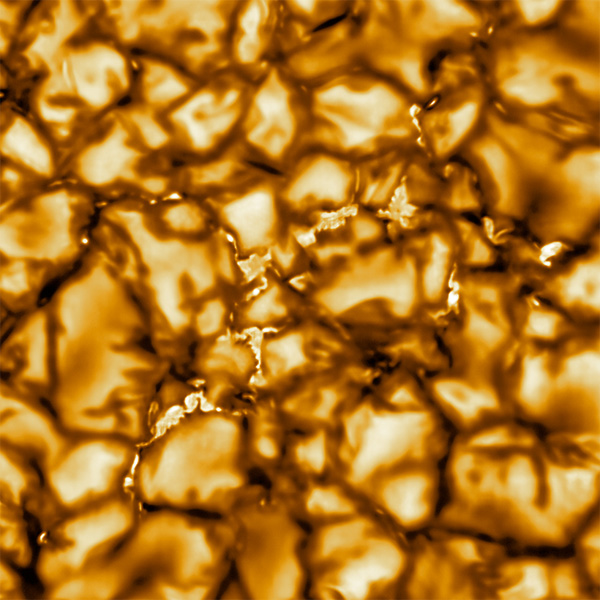
The "first light" image above from DKIST shows features as small as 30 km. In addition to usual bright centers and dark edges of the convections cells seen with earlier solar telescopes, this image shows for the first time very clearly the thin bright markers of magnetic fields in the dark edges that might be responsible for channeling energy up into the corona.
Solar Atmosphere
Moving outward from the core to the surface of the Sun, the temperature and density of the gas decreases. This trend in the density continues outward in the Sun's atmosphere. However, the temperature increases above the photosphere. The cause of the temperature increase is not well known but it involves some combination of sonic waves and magnetic waves from shaking magnetic loops above sunspots, numerous nanoflares, and wiggling jets in the chromosphere known as spicules to heat the atmosphere. Observations with the NSF Dunn Solar Telescope show that magnetic waves can be intensified and magnified through "acoustic resonators" formed from changes in temperature between the photosphere and corona.Chromosphere
During solar eclipses a thin pink layer can be seen at the edge of the dark Moon. This colorful layer is called the chromosphere (it means ``color sphere''). The chromosphere is only 2000 to 3000 kilometers thick. Its temperature rises outward away from the photosphere. Because it has a low density, you see emission lines of hydrogen (mostly at the red wavelength of 656.3 nanometers) 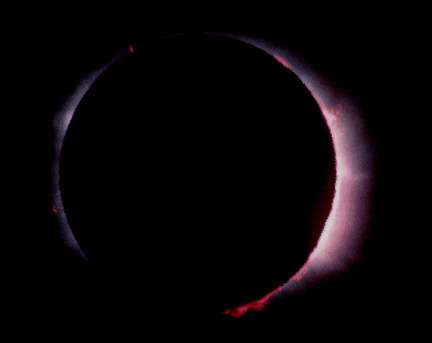 --
-- 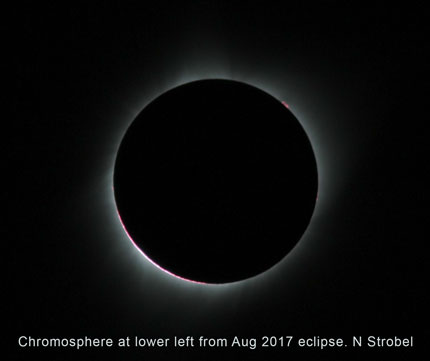
The thin chromosphere is visible in these solar eclipse pictures.
Images of today's chromosphere are available on the National Solar Observatory's GONG website.
Corona
When the new Moon covers up the photosphere during a total solar eclipse, you can see the pearly-white corona around the dark Moon. This is the rarefied upper atmosphere of the Sun. It has a very high temperature of one to two million Kelvin. Despite its high temperature, it has a low amount of heat because it is so tenuous. 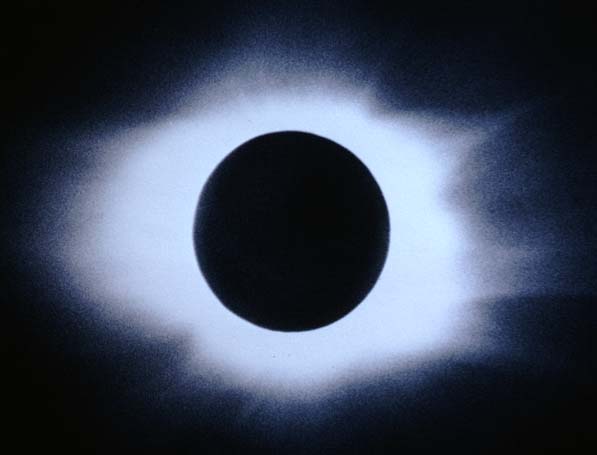 --
-- 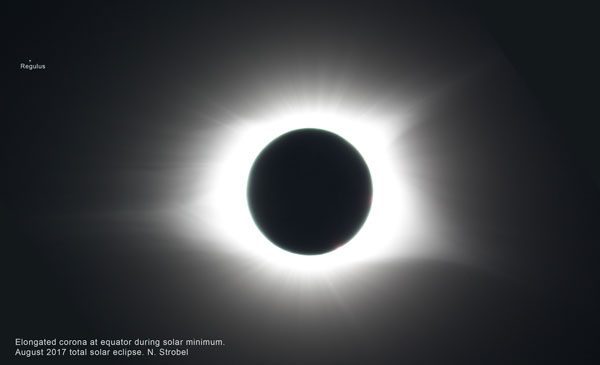
Total solar eclipse in 1973 (left or top, courtesy of Fred Espenak) and in 2017 (right or bottom) showing the corona near solar maximum activity (1973) and near solar minimum activity (2017). During solar maximum the corona looks more uniform around the entire sun while during solar minimum the corona has bright bulbs closer to the equator, called helmet streamers, and fainter, straight structures at the poles called polar plumes. For more about the corona shape connection to solar activity, see the Eclipse 2017 website's Solar Corona page.
The corona is known to be very hot because it has ions with many electrons removed from the atoms. At high enough temperatures the atoms collide with each other with such energy to eject electrons. This process is called ionization. At very high temperatures, atoms like iron can have 9 to 13 electrons ejected. Nine-times ionized iron is only produced at temperatures of 1.3 million K and 13-times ionized iron means the temperature gets up to 2.3 million K! During strong solar activity, the temperature can reach 3.6 million K and lines from 14-times ionized calcium are seen.
Most of the corona is trapped close to Sun by loops of magnetic field lines. In X-rays, those regions appear bright. Some magnetic field lines do not loop back to the Sun and will appear dark in X-rays. These places are called ``coronal holes''. The sequence of pictures shows the increasing level of solar activity as the Sun headed toward solar maximum in the year 2000.
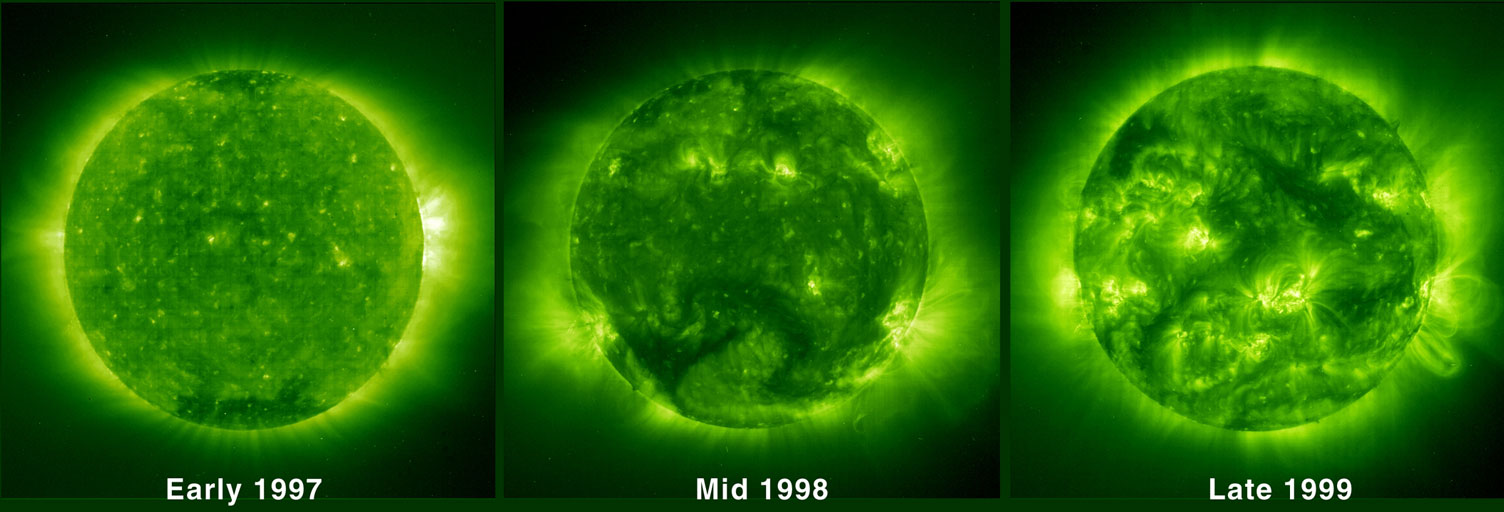
More details in the corona are seen when looking in the higher energy regions of the electromagnetic spectrum than visible light (extreme ultraviolet image from the SOHO spacecraft, courtesy of NASA and ESA).
Images of today's corona and the transition zone between the chromosphere and corona are available on the SOHO website, the Solar Dynamics Observatory website, and the Daniel K. Inouye Solar Telescope website (they also have timelapse movies)
Other pictures in stereo (use 3D cyan-red glasses), movies, and other data of the Sun's corona are available from NASA's STEREO mission (and other site)---two nearly identical space observatories, one ahead of the Earth in its orbit and one trailing behind, will trace the flow of energy and matter from the Sun to the Earth.
Fast-moving ions can escape the Sun's gravitational attraction. Moving outward at hundreds of kilometers/second, these positive and negative charges travel to the farthest reaches of the solar system. They are called the solar wind. The solar wind particles passing close to a planet with a magnetic field are deflected around the planet. Fluctuations in the solar wind can give energy to the trapped charged particles in the planet's radiation belts. Particles with enough energy can leave the belts and spiral down to the atmosphere to collide with molecules and atoms in the thermosphere of the planet. When the charged particles hit the planet's atmosphere, they make the gas particles in the atmosphere produce emission spectra---the aurorae (see the aurorae section in the planets chapter for more details). During solar maximum the increased number and energy of the solar wind particles produce more extensive auroral displays in the Earth's atmosphere---the aurorae can even be seen by those at latitudes near 30° north or south! Usually, aurorae are seen by only those above 50° N latitude (or 50° S latitude for the aurora australis). The effects of the solar wind on the Earth is described more fully in the NOAA Space Weather Prediction Center and NASA's Solar Dynamics Observatory.
Vocabulary
| aurorae | chromosphere | convection zone |
|---|---|---|
| core (stellar) | corona | granulation |
| ionization | photosphere | radiative zone |
| solar wind | sunspots |
Formulae
Review Questions
- What are the two main gases in the Sun? How does the Sun's mass and size compare with Jupiter?
- What goes on in the core, radiative zone, and convection zone of the Sun?
- Describe the three ways astronomers use to find that the photosphere is about 5800 K.
- What are some of the characteristics of sunspots? What is the sunspot cycle?
- Do all surface layers of the Sun rotate at the same rate? How can you tell?
- What produces the granulation on the surface of the Sun?
- What are prominences and flares? How are they associated with solar activity? How is their number correlated with the number of sunspots?
- How can we tell that the chromosphere and corona are over 6000 K (some parts reaching a few million degrees). What are ``coronal holes''?
- What is the association of the magnetic field with the sunspots and solar atmosphere?
- How is the solar wind associated with aurorae?
![]() Go back to previous section --
Go back to previous section -- ![]() Go to next section
Go to next section
Go to Astronomy Notes home -- Please support this website
last updated: June 19, 2022
Is this page a copy of Strobel's Astronomy Notes?
Author of original content: Nick Strobel
Source: https://www.astronomynotes.com/starsun/s2.htm
0 Response to "He Interior of the Sun Effectively Produces a Continuous Spectrum These Photons Escape to Space"
Post a Comment